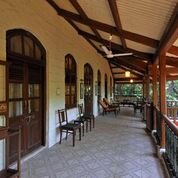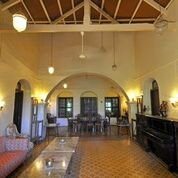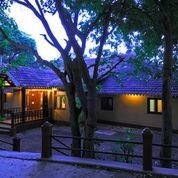Bringing Past into Present: Renowned Architect Sonica Arya Talks British Raj Matheran Hill Station
Photo From Gozocabs.com
“Move aside,move aside!” I hear the attendant say as I move to the edge of the pathway and watch the group of mules carrying bags strung on either side of their backs, trot up the steep, hilly terrain.
It is a sight I’m familiar with, at this environment friendly hill station I frequent regularly for the restoration and remodelling of the Colonial heritage bungalows.
Matheran is one of the very few places in the world that does not allow any vehicles at all, so the moment you step into this little town, you will be transported back to an idyllic, old-world era of red-soil roads, automobile-free pathways and lush green hills all around. The cold breeze and the fresh air, devoid of pollution is reason enough for tourists to throng to Matheran all year round.
Nestled amidst the Sahyadri range on the Western Ghats, Matheran, with its name literally translating to “overhead forest”, is a cosy little hill station that stands at an elevation of 2600 feet above sea level, and is just 100 kilometres away from Mumbai, making it the perfect weekend getaway.
It became a quaint getaway or hill station (in the British Raj parlance) that was established in the hills of the Sahyadri range in the mid 19th century. Matheran was identified by Hugh Poyntz Malet, the then district collector of Thane district in May 1850. Lord Elphinstone, the then Governor of Bombay laid the foundations of the development as a future hill station. The British developed Matheran as a resort to beat the summer heat in the region. Its altitude gave the British population in Mumbai a relief from the heat of the city and its beautiful trees and muddy paths, an excellent opportunity to ride horses. The Matheran Hill Railway was built in 1907 by Sir Adamjee Peerbhoy and covers a distance of 20 km (12 mi), over large swathes of forest territory. The railway twists up the hill and eventually runs parallel to the popular marketplace , and the whistles of the train are a familiar sound for residents and regulars.
In present times the vehicular traffic has to be parked at the base of the hill and people either walk up or ride up on horses. The older or infirm even resort to hand rickshaw where 2 men will pull you up in a vehicle. It is the only vehicle free hill station in Asia and still retains its Raj charm with the bungalows from the 19th century and a lake named Charlotte and different viewing points called Myrra, Louisa, Hart, Alexander and One Tree Top Hill. It even has the Olympia, a race course for the horses. Talk of Royal Raj Living! The marketplace has local shops of jams, marmalades, honey and chikki (a brittle made of jaggery and nuts) and shops selling local Kolhapuri footwear. You can well picture the English riding down the Mall Road in their Jodhpurs in the 1850’s.
The bungalows I was working on were all typical gabled roof ground level structures made with the local laterite stone used for external walls and British masonry for the internal walls. Upon stripping the plaster off the walls, we saw a fine semicircular arch made in the wall to give it extra support and balance, a practice common in the Gothic architecture by the British designers in Mumbai.
The beautiful wooden trusses with high ceiling heights had big girths and were of very good quality Burma Teak wood - reminding one of the influence of the British empire that supplied its wood from Burma to its different colonies.
To repair and redo some of the ones that were damaged we had to get them from the old havelis from Gujarat as the sizes and sections were rare and not available in the local market. The newly made King Truss stood majestically high and had fans hanging with long rods in the different rooms. None of the homes had T.V.or air conditioning and used solar panels for electricity.
Due to the incessant rains during the rainy season one had to have very deep ridges and gutters along the eaves to drain the water. The charming local design was incorporated in the wooden fascia boards running along the roof the entire periphery of the home.
Another unique feature most of these bungalows have is that they had a separate kitchen block with stone flooring and an open passage area outside where the local lady cook would sit and hand grind the masalas (spices) on a stone grinder. The freshness and texture cannot be compared to the electrical machine ground masalas.
They also had outhouses for the local staff that would stay here whilst the Sahibs would be back to work in Mumbai.
The plumbing and drainage also had to be redesigned in these homes as most toilets were earlier designed as a separate common block with dry sanitation. New soak pits were created as these homes were not attached to a common sewage system.
Now each room has an attached toilet and beautiful old almirahs, four poster high beds and wooden towel stands were fitted in. We sourced the old Minton tiles made in Japan and still available in chor Bazar (thieves market) in Mumbai. These were vividly coloured ceramic glazed tiles with typically British patterns, made in relief on them.
The woods surrounding the homes made it necessary to allow natural light to come into the rooms, not only from the windows but also through glass tiles interspersed with the clay Mangalore tiles in the roof and skylights made at crucial points.
In the rooms we fixed the cement tiles on the floor with the designs typical of the Raj Era. They are still being manufactured by a Parsi family owned company in Mumbai. They have to be laid in situ and the floor is polished on site and the joints are grouted to match the floor. It recreates the ambience and aura of the Raj era beautifully.
Watching all this material coming up on mules and hand carts I would feel that time has come to a stand still here. There are electricity cuts due to which we would have to stop work and in the rains this hill station is non operable for 3-4 months.
We faced a challenge with the monkeys that inhabit the forests in large numbers and were constant unwelcome visitors to the sites. From dancing on the roof and breaking our tiles to attacking us whilst we ate our picnic lunch of food brought and packed in the wee hours of the morning from Mumbai, we witnessed every trick in their bag. The town also has a large variety of bonnet macaques and Hanuman langurs. Domesticated horses for riding are also in large numbers and are one of the symbols of Matheran. Inside the forest, animals like barking deer, Malabar giant squirrel, fox, wild boar and mongoose may be found. There have been reports of leopard sightings in Matheran a few times in the last decade. Leopards are not known to dwell in Matheran, but due to dense forests in valleys surrounding Matheran, leopards who are on the prowl may climb Matheran.
The labourers were local and understood only colloquial terms, so it was a cohesive effort to reproduce balcony railings and restore the keystones on the windows so that the homes were restored to their former glory. What glee we felt at discovering an old fireplace (closed by a faux wall made by a subsequent inhabitant) and adding a brass railing and polishing the mantelpiece that we now displayed with pride.
Where the horses used to be tied up, we made that into a beautiful courtyard with urns and some green plants. Landscaping was not possible due to poor soil depth, and the vegetation on the edges of the plateaus is poor. Due to heavy rainfall, dissected hilly terrain and excessive leaching of the soil, the exposed areas become less fertile and become less moisture retentive, resulting in shallow rooted vegetation.
After two years of toiling on each project these homes were ready for the new inhabitants. Vintages of history being passed from a Colonial master after 150 years to proud Indians who would use these holiday homes as their weekend getaways from Mumbai.
It was extremely satisfying being part of this challenging experience, revisiting the past and interpreting it for the modern day usage and still retaining the history and the uniqueness of these homes.
Sonica Arya graduated from the Academy of Architecture in Mumbai. She has worked on a variety of projects ranging from residential homes to outhouses, and commercial projects such as banks and hotels. She conceptualized, designed and executed the showroom design for the designer jewellery brand “Tanishq” of the Tata Group and has a keen interest in remodelling heritage properties such as those in Matheran, outside of Mumbai.
She is an avid reader, an art connoisseur and loves travelling, especially places that have a strong historical, cultural and architectural heritage. She lives with her husband and two teen daughters in Mumbai, India.
Check out the gallery of the Matheran Bungalows Below:
A Beautiful Gallery of Bungalows in Matheran Designed by Sonica Sharma
WHO WE ARE
WOMEN WHO WIN IS THE GLOBAL ONLINE MEDIA PLATFORM AND NETWORKING GROUP FOR WOMEN, WHERE WE SHARE THE DREAMS OF DYNAMIC WOMEN ACROSS THE WORLD, AND THE INSPIRATIONAL SECRETS BEHIND THEIR SUCCESS.
CO-FOUNDED BY DR. MANJU SHETH, A PHYSICIAN, COMMUNITY LEADER, AND WELL-KNOWN MEDIA PERSONALITY IN BOSTON. SHE IS THE CREATOR OF THE CHAI WITH MANJU INTERVIEW SERIES, AND PRESTIGIOUS NEW ENGLAND CHOICE AWARDS.
DR. DEEPA JHAVERI, AN EXPERIENCED PODIATRIST AND LEADER OF THE PRESTIGIOUS INDIAN MEDICAL ASSOCIATION IN BOSTON.
AND CO-FOUNDED BY SHALEEN SHETH, A RECENT GRADUATE OF BABSON COLLEGE. SHE WORKS FOR WAYFAIR IN E-COMMERCE PROGRAM. SHE IS A FINANCE MAJOR INTERESTED IN FIN-TECH, AND HAS WORKED SEVERAL DIGITAL MARKETING ROLES DURING HER COLLEGE YEARS.
FOR MORE ON OUR FOUNDERS, CHECK OUT FOUNDERS TAB.
IF YOU HAVE A STORY TO SHARE, REACH OUT TO WOMENWHOWIN100@GMAIL.COM
WOMEN WHO WIN #DREAMCATCHERS, ALONG WITH THE NAMES OF ALL 3 CO-FOUNDERS MUST BE CREDITED WHEREVER ARTICLE CONTENTS ARE SHARED. COPY-PASTING THE STORY WITHOUT THESE CREDITS IS PROHIBITED





